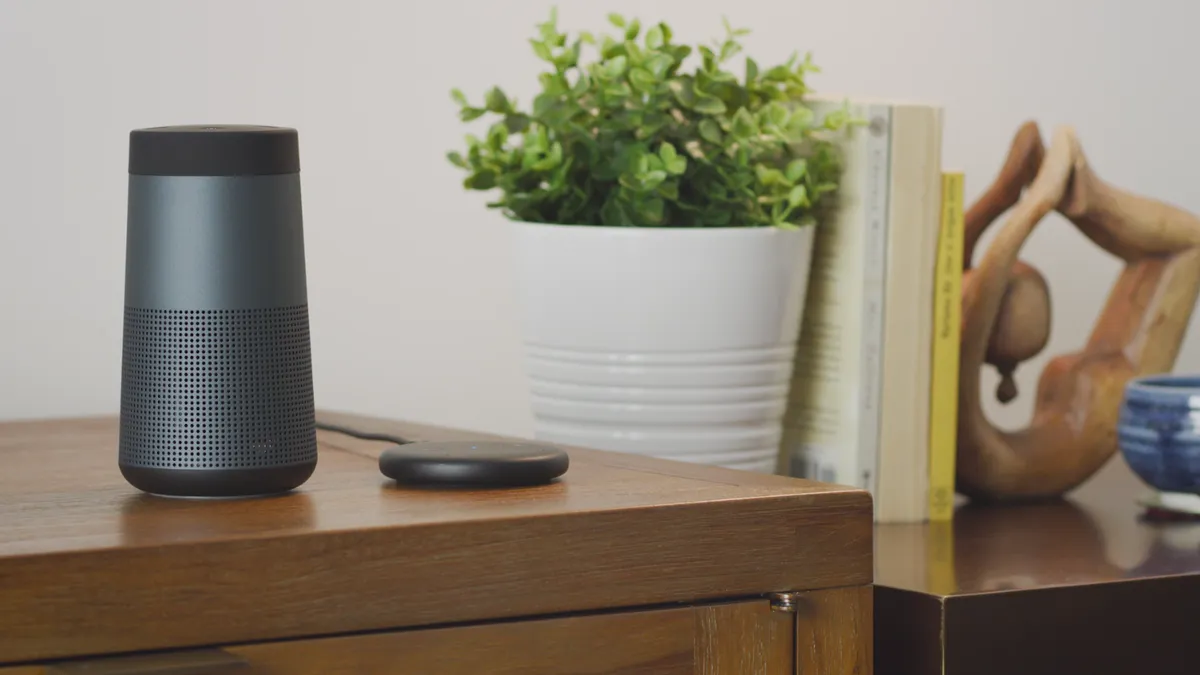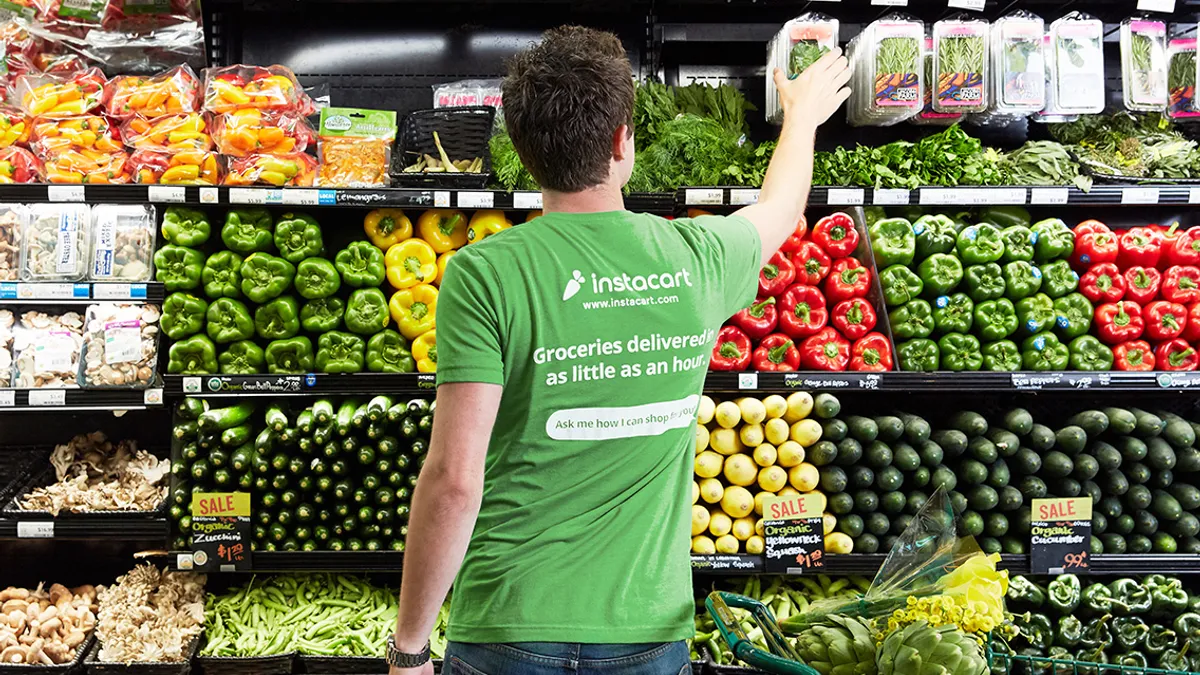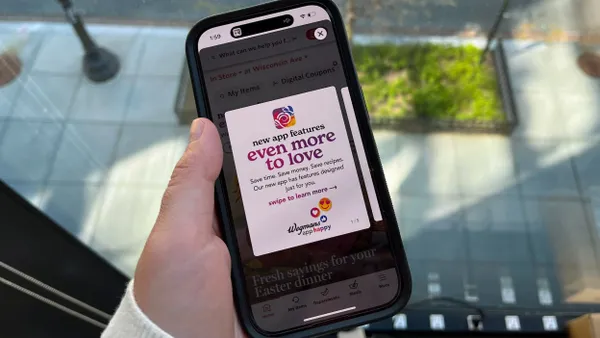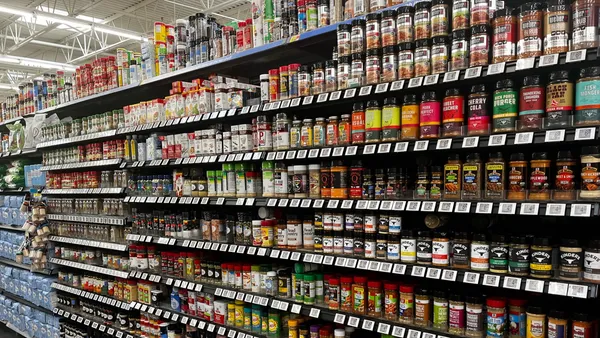Editor’s note: This story is the first installment in a monthly series looking at some of the biggest investments grocers and food companies are making. Previous articles sponsored by BMO Harris Bank can be found here.
"Hey Google, set my alarm for 8:30 a.m. tomorrow."
"Hey Alexa, what’s the weather like outside?"
These are among the most common demands and questions for voice-controlled personal assistants and smart speakers. But once consumers say "Alexa, order me bananas, Honey Nut Cheerios and a loaf of bread," difficulties arise. How many bananas? A pound? How ripe? What size box of Cheerios? And what type of bread and what brand?
Conversational commerce, as it is called, is still in its infancy across all industries, Jon Reily, vice president of commerce strategy at Publicis.Sapient, told Grocery Dive. Every retailer, from department stores to grocers, is trying to figure out how best to use it, he said.
But food retailers do have an advantage, Reily noted. Unlike other verticals like clothing stores where all products need to be seen before purchasing, much of grocery shopping is replenishment of items like cereal, cat litter, batteries or paper towels.
“I think simplicity is the easiest way to do it where there’s a lot of repeat purchases of groceries we do on a weekly basis and it’s easy to purchase things like laundry detergent," Carolina Milanesi, consumer tech analyst at Creative Strategies, told Grocery Dive. "It has a clear brand and you don’t have to specify the details of the actual product."
The problem, she said, is that consumers are creatures of habit. It’s going to take a lot more development from retailers, she said, to iron out the friction-riddled shopping experience of voice ordering.
“Consumers want convenience in whichever form it comes," said Milanesi. "It’s not quite convenient yet because it is complex and it might not understand the consumer due to background noises or accents."
Adding skills and curbing impulse buys
Voice commerce sales last year totaled $2.1 billion, according to eMarketer. That's equal to less than half of 1% of all U.S. e-commerce sales.
According to Gartner, consumers still prefer in-store shopping versus all else. About 62% of those surveyed preferred a physical store, 26% chose the web, 7% mobile and only .58% on a smart speaker. Most consumers who do use voice-controlled programs use them to research products, not buy them, eMarketer recently noted.
Nevertheless, some grocers have already adopted voice technology. Last year, Peapod launched an "Ask Peapod" skill for Alexa that allows consumers to voice order items that are added to the shopper's weekly grocery carts. Kroger partnered with the Google Assistant voice app, which can be accessed through not only Google Assistant, but also iOS and Android. Google is also a partner with Target and also Walmart, but last week Walmart revealed it had dropped Google's Shopping Actions service, which included voice ordering.
In order to use voice shopping through Amazon, retailers are using skills which have to be added to consumers' devices. Unfortunately, people don't use skills very often and there's a barrier of entry to install a skill, according to Reily. He explains that once the initial process of enabling a skill is through, which in itself takes multiple steps via the Alexa or Amazon app, users might have to go through an extensive initial set-up process depending on the complexity of the skill. Then to activate the skill they must say "Alexa, ask Peapod to add milk to my cart."
According to data from Dashbot via Business Insider Intelligence, 53% of Echo owners enable one to three Alexa skills and 14% use none at all.
For reference, the number one skill installed on the one million Amazon Echos is the Ring doorbell and even that only has about 60,000 installations, according to Reily.
“I think the biggest hurdle is that it still feels faster if I just sit at the computer and do it versus going through all these steps," said Milanesi. "Muscle memory is the hardest thing to change in consumers."
Profitable shopping habits and merchandising practices, meanwhile, often get lost in the translation from shelves and digital to voice. Impulse purchasing, which annually total around $5,400 per U.S. consumer, is a big business that doesn't easily translate to conversational converse, Milanesi explained.
Customers shopping online don't have the ease of reaching for a bag of M&Ms at checkout. But retailers are trying to simulate that experience by enticing customers with impulse purchases as they make their way to final purchase. Snacks, candy and even baked goods are products that can be teased and then tacked on to an order.
However, the same ability to entice customers doesn't exist in voice shopping. The same goes for offering discounts, specials and sales on products. With voice shopping, consumers don’t always know what the offers are and a lot of times it’s the promotional offers that drive them to buy a specific brand, Bob Hetu, vice president and retail analyst at Gartner, told Grocery Dive.
In order to do communicate discounts and offers to shoppers, Reily thinks there needs to be a two-way conversation between the consumer and the retailer using voice technology without the cloud disrupting the process. As of right now, when a device is activated, it records what is said, sends it to the cloud, gets a response on the items the consumer wants and then sends it back. “Until those conversations take place locally and don’t need the cloud to get a response it’s going to be difficult to get that one to one conversation where you can speak to the machine to tell it exactly what you want,” he added.
Aiding list management
Despite voice shopping's limitations right now, retailers are finding ways to effectively implement the technology.
In the U.K., e-grocer Ocado along with conventional grocer Morrisons have partnered with Amazon's Alexa on a voice skill that manages consumers' shopping lists.
"With the Ocado skill, customers can use their voice to add to and remove items from future orders or orders they’ve already completed," a post announcing the technology reads. "They can also ask for updates on order status and ask what’s in season."
During a recent industry presentation, Matt Kelleher, managing director with U.K. grocer Morrisons, said 1% of its shoppers are now using its Alexa-enabled voice-ordering service, which launched back in 2017. He said the typical shopper uses the platform three to four times a week. Kelleher explained that voice technology still has some kinks to work out including distinguishing between accents, but says it is "at a tipping point" with consumers.
"I think the biggest hurdle is that it still feels faster if I just sit at the computer and do it versus going through all these steps."

Carolina Milanesi
Consumer tech analyst, Creative Strategies
Retailers can use incentives and gentle reminders to get shoppers to trial voice ordering, analysts said. During Prime Day, Amazon sends an email to Echo owners notifying consumers to ask their Alexa device for certain exclusive offers. Once shoppers use Alexa, the device performs certain marketing functions, including suggesting future items for purchase after a shopper checks out.
Unfortunately today, most retailers don’t have the data and understanding of each customer that Amazon does to personalize notifications, said Hetu. And if personalization isn't done right, he said, then it’s just an annoyance to the shopper.
Amazon, Google and beyond
Analysts see voice technology evolving significantly in the years ahead.
Over the next 10 years, Reily said, Apple, Facebook, Google and Amazon will spend an estimated $750 trillion dollars to research and develop voice recognition to see who can take control of the market.
Milanesi believes that adding a screen to voice devices, similar to the Echo Show, will help conversational commerce — not as a crutch but as an enabler of problem-solving. “If you are undecided and you see three different products that could fit your description and you just quickly tap on it, then that’ll help,” she said.
Amazon's ability to gather large quantities of data through e-commerce and voice shopping gives it a sizable advantage over other retailers, analysts noted. Google, on the other hand, has attempted to boost its presence in commerce with Shopper Actions, which includes optimized search and its voice-ordering assistant.
The battle between Apple, Facebook, Google and Amazon makes it difficult for grocers because they aren’t a master of their own destiny, said Reily. In addition, working with Amazon creates problems of its own since the company, which runs Whole Foods Market and is the U.S.'s leading online grocer, is now a major competitor.
“At its very base level, until they’re forced to at a regulatory level, Amazon will not level the playing field so that another retailer like Kroger can rank equal to their offerings,” he said.
Analysts agree that it’s going to take a while for voice shopping to mature. As of now, e-commerce accounts for anywhere between 2% to 5% of overall grocery sales — but that's expected to accelerate over the next few years as innovation and retailer services expand. So while retailers are looking for new ways to reach consumers, they’re also focused on laying down an e-commerce foundation first.
Ultimately the growth of voice shopping will lie in training the assistant to be smarter and know what the different choices of products are and then remembering personal preferences to make shopping easier the second time around, Milanesi said. But the ultimate reach of conversational commerce may be limited.
“I don’t believe all of our shopping will be done by voice by any stretch of the imagination," she added. "There are certain things where it makes sense and some where it just doesn’t work. The same way where I don’t think all of our interactions with a computing device will be done with voice. We just aren’t wired that way."
Correction: This story has been updated to reflect the fact that Kroger does not have an Alexa skill.
This series is brought to you by BMO Harris Bank, a leader in commercial banking. To learn more about their Food & Beverage expertise, visit their website here. BMO Harris Bank has no influence over Grocery Dive's coverage.





















